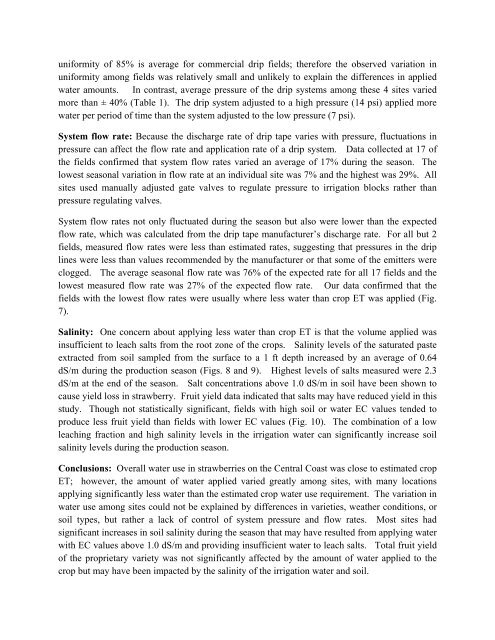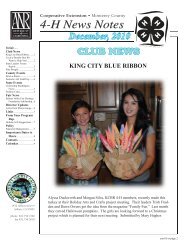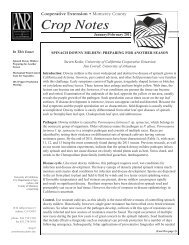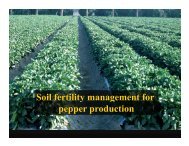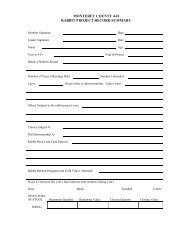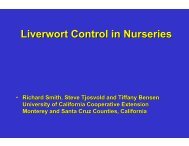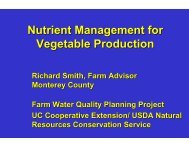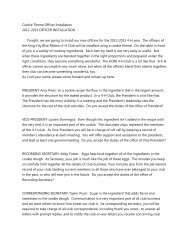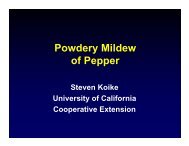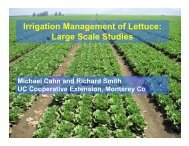Strawberry water use on the Central Coast Michael Cahn, Barry ...
Strawberry water use on the Central Coast Michael Cahn, Barry ...
Strawberry water use on the Central Coast Michael Cahn, Barry ...
You also want an ePaper? Increase the reach of your titles
YUMPU automatically turns print PDFs into web optimized ePapers that Google loves.
uniformity of 85% is average for commercial drip fields; <strong>the</strong>refore <strong>the</strong> observed variati<strong>on</strong> in<br />
uniformity am<strong>on</strong>g fields was relatively small and unlikely to explain <strong>the</strong> differences in applied<br />
<str<strong>on</strong>g>water</str<strong>on</strong>g> amounts. In c<strong>on</strong>trast, average pressure of <strong>the</strong> drip systems am<strong>on</strong>g <strong>the</strong>se 4 sites varied<br />
more than ± 40% (Table 1). The drip system adjusted to a high pressure (14 psi) applied more<br />
<str<strong>on</strong>g>water</str<strong>on</strong>g> per period of time than <strong>the</strong> system adjusted to <strong>the</strong> low pressure (7 psi).<br />
System flow rate: Beca<str<strong>on</strong>g>use</str<strong>on</strong>g> <strong>the</strong> discharge rate of drip tape varies with pressure, fluctuati<strong>on</strong>s in<br />
pressure can affect <strong>the</strong> flow rate and applicati<strong>on</strong> rate of a drip system. Data collected at 17 of<br />
<strong>the</strong> fields c<strong>on</strong>firmed that system flow rates varied an average of 17% during <strong>the</strong> seas<strong>on</strong>. The<br />
lowest seas<strong>on</strong>al variati<strong>on</strong> in flow rate at an individual site was 7% and <strong>the</strong> highest was 29%. All<br />
sites <str<strong>on</strong>g>use</str<strong>on</strong>g>d manually adjusted gate valves to regulate pressure to irrigati<strong>on</strong> blocks ra<strong>the</strong>r than<br />
pressure regulating valves.<br />
System flow rates not <strong>on</strong>ly fluctuated during <strong>the</strong> seas<strong>on</strong> but also were lower than <strong>the</strong> expected<br />
flow rate, which was calculated from <strong>the</strong> drip tape manufacturer’s discharge rate. For all but 2<br />
fields, measured flow rates were less than estimated rates, suggesting that pressures in <strong>the</strong> drip<br />
lines were less than values recommended by <strong>the</strong> manufacturer or that some of <strong>the</strong> emitters were<br />
clogged. The average seas<strong>on</strong>al flow rate was 76% of <strong>the</strong> expected rate for all 17 fields and <strong>the</strong><br />
lowest measured flow rate was 27% of <strong>the</strong> expected flow rate. Our data c<strong>on</strong>firmed that <strong>the</strong><br />
fields with <strong>the</strong> lowest flow rates were usually where less <str<strong>on</strong>g>water</str<strong>on</strong>g> than crop ET was applied (Fig.<br />
7).<br />
Salinity: One c<strong>on</strong>cern about applying less <str<strong>on</strong>g>water</str<strong>on</strong>g> than crop ET is that <strong>the</strong> volume applied was<br />
insufficient to leach salts from <strong>the</strong> root z<strong>on</strong>e of <strong>the</strong> crops. Salinity levels of <strong>the</strong> saturated paste<br />
extracted from soil sampled from <strong>the</strong> surface to a 1 ft depth increased by an average of 0.64<br />
dS/m during <strong>the</strong> producti<strong>on</strong> seas<strong>on</strong> (Figs. 8 and 9). Highest levels of salts measured were 2.3<br />
dS/m at <strong>the</strong> end of <strong>the</strong> seas<strong>on</strong>. Salt c<strong>on</strong>centrati<strong>on</strong>s above 1.0 dS/m in soil have been shown to<br />
ca<str<strong>on</strong>g>use</str<strong>on</strong>g> yield loss in strawberry. Fruit yield data indicated that salts may have reduced yield in this<br />
study. Though not statistically significant, fields with high soil or <str<strong>on</strong>g>water</str<strong>on</strong>g> EC values tended to<br />
produce less fruit yield than fields with lower EC values (Fig. 10). The combinati<strong>on</strong> of a low<br />
leaching fracti<strong>on</strong> and high salinity levels in <strong>the</strong> irrigati<strong>on</strong> <str<strong>on</strong>g>water</str<strong>on</strong>g> can significantly increase soil<br />
salinity levels during <strong>the</strong> producti<strong>on</strong> seas<strong>on</strong>.<br />
C<strong>on</strong>clusi<strong>on</strong>s: Overall <str<strong>on</strong>g>water</str<strong>on</strong>g> <str<strong>on</strong>g>use</str<strong>on</strong>g> in strawberries <strong>on</strong> <strong>the</strong> <strong>Central</strong> <strong>Coast</strong> was close to estimated crop<br />
ET; however, <strong>the</strong> amount of <str<strong>on</strong>g>water</str<strong>on</strong>g> applied varied greatly am<strong>on</strong>g sites, with many locati<strong>on</strong>s<br />
applying significantly less <str<strong>on</strong>g>water</str<strong>on</strong>g> than <strong>the</strong> estimated crop <str<strong>on</strong>g>water</str<strong>on</strong>g> <str<strong>on</strong>g>use</str<strong>on</strong>g> requirement. The variati<strong>on</strong> in<br />
<str<strong>on</strong>g>water</str<strong>on</strong>g> <str<strong>on</strong>g>use</str<strong>on</strong>g> am<strong>on</strong>g sites could not be explained by differences in varieties, wea<strong>the</strong>r c<strong>on</strong>diti<strong>on</strong>s, or<br />
soil types, but ra<strong>the</strong>r a lack of c<strong>on</strong>trol of system pressure and flow rates. Most sites had<br />
significant increases in soil salinity during <strong>the</strong> seas<strong>on</strong> that may have resulted from applying <str<strong>on</strong>g>water</str<strong>on</strong>g><br />
with EC values above 1.0 dS/m and providing insufficient <str<strong>on</strong>g>water</str<strong>on</strong>g> to leach salts. Total fruit yield<br />
of <strong>the</strong> proprietary variety was not significantly affected by <strong>the</strong> amount of <str<strong>on</strong>g>water</str<strong>on</strong>g> applied to <strong>the</strong><br />
crop but may have been impacted by <strong>the</strong> salinity of <strong>the</strong> irrigati<strong>on</strong> <str<strong>on</strong>g>water</str<strong>on</strong>g> and soil.


